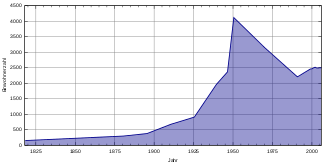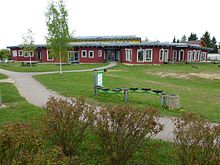Großlehna
|
Großlehna
Markranstädt municipality
Coordinates: 51 ° 18 ′ 0 ″ N , 12 ° 10 ′ 0 ″ E
|
||
|---|---|---|
| Height : | 115 m above sea level NN | |
| Area : | 12.03 km² | |
| Residents : | 2494 (May 30, 2005) | |
| Population density : | 207 inhabitants / km² | |
| Incorporation : | January 1, 2006 | |
| Postal code : | 04420 | |
| Area code : | 034205 | |
|
Location of Großlehna in Saxony |
||
Großlehna (previously officially written Groß Lehna ) is a village and a district of the Saxon town of Markranstädt in the Leipzig district .
geography
Until the incorporation, Großlehna consisted of the three districts Großlehna, Kleinlehna and Altranstädt . South of Großlehna the brook arises from the confluence of the Wiesengraben and Renne.
The place is located directly on the border between Saxony and Saxony-Anhalt about ten kilometers west of Leipzig and is connected to the railway line Leipzig-Großkorbetha with the Großlehna stop . The federal motorway 9 ( Munich - Berlin ), the federal road 186 (Markranstädt - Schkeuditz ) and the Saxon state road 77 also run through Großlehna .
The district Großlehna borders in the northeast on Priesteblich and Lindennaundorf, in the east and southeast on Markranstädt and in the south on Quesitz (all districts of Markranstädt). The corridors of the cities of Bad Dürrenberg and Leuna in the Saalekreis in Saxony-Anhalt are located to the west of the town marker .
Großlehna is a stop on the Grüner Ring Leipzig cycle path .
history
The fertile, but poorly forested Leipzig lowland bay was already settled in prehistory and early history. Evidence of this settlement is provided by a burial site of the bell beaker culture in the area of the Großlehna industrial park. As a next step, the emergence of Kleinlehna by Sorbian settlers for whom no exact year is known can be assessed. The first secure mention was made on August 1, 1091 for the village of Altranstädt and about 130 years later on June 10, 1224 for Großlehna as a leash .
In the Doppelgasse village of Altranstädt, the Cistercians settled and founded a monastery, which was primarily known for its sheep breeding. This manor was a grangie of the Cistercian monastery Altzelle near Nossen. The management of the places Großlehna, large and small Glasau which later deserted villages degenerated, and Oetzsch, Treben and small-Miltitz was carried out by the estate in Altranstädt. In a document from 1291 there is even talk of a court seat that Landgrave Albert left to the Merseburg Monastery. The status of the monastery property with the associated village existed until the secularization of the Altzelle monastery in 1540 by the Saxon Duke Heinrich the Pious as a result of the Reformation .
Administratively, Großlehna and Kleinlehna belonged to the Electorate and Kingdom of Saxony until 1815 . Since the secularization of Altranstäder manor in 1540 belonging to Gutsbezirk places came Altranstädt , Großlehna and small-Miltitz and Treben and Oetzsch as enclaves in high pin-merseburgischen Office Lutzen the district office Leipzig . Kleinlehna, however, was Amtsdorf in the office of Lützen. As a result of the resolutions of the Congress of Vienna , Altranstädt, Großlehna, Treben and Oetzsch with the western part of the Lützen district, to which Kleinlehna belonged, were ceded to Prussia in 1815. In the new political order Prussia they were in 1816 the county Merseburg in the administrative district of Merseburg of the Province of Saxony allocated to which they belonged to the 1952nd The construction of the important railway line from Leipzig to Großkorbetha began in 1856, but Großlehna only got a stop on this connection in 1893. In 1923 the Großlehna volunteer fire brigade was founded, which had existed in Altranstädt since 1882.
Kleinlehna was incorporated into Großlehna on October 1, 1939. Both places remained with Prussia until 1945. After the Second World War , the community became part of the Soviet occupation zone and thus later the GDR . It belonged to the state of Saxony-Anhalt until the founding of the districts in the GDR in 1952. With the district reform in 1952 , the community became the district of Leipzig-Land in the Leipzig district , with which it remained in the newly founded Free State of Saxony after the fall of the Berlin Wall and reunification . In the subsequent district reform in 1994 , the old districts became the new district of Leipziger Land , to which Großlehna belonged as an independent municipality until 2006.
On July 1, 1950, the previously independent municipality of Altranstädt was incorporated.
On January 1, 2006, Großlehna's independence ended when it was incorporated into the town of Markranstädt. The community became a village with the districts Großlehna and Altranstädt. Kleinlehna was stripped of its district status on this move.
Population development
The (rural) community Großlehna was a rural village. At the beginning of the 20th century, the place recorded a large increase in population, which can also be explained by the incorporation of Kleinlehna (1939 with ~ 400 inhabitants) and Altranstädt (1949 with ~ 1800 inhabitants). The highest recorded number of inhabitants was reached in 1950 with 4120 inhabitants, afterwards it fell to 2207 people in 1990 and has now stabilized at around 2500 inhabitants.
|
|
|
Culture and sights
In 2005 the primary school " Nils Holgersson " opened with an attached gym. The local shopping center and the fire station are also in the immediate vicinity. The Großlehna village church is another cultural center .
The largest clubs in Großlehna are the wrestling club Großlehna 1999, the football club Blau-Weiss Großlehna , which plays in the city league, and the chess club Großlehna (since 1945, women's chess team in the national chess league).
Another tradition since 1997 has been the annual enlargement of the "Saxe Forest" near the A9. Through this campaign, with the help of the municipality of Markranstädt, the Forest for Saxony Foundation and the Saxe car dealership, an area of almost 10 hectares with 39,000 trees and bushes has been sustainably reforested.
Web links
Individual evidence
- ↑ Karlheinz Blaschke , Uwe Ulrich Jäschke : Kursächsischer Ämteratlas , Leipzig 2009, ISBN 978-3-937386-14-0 , p. 60 f.
- ^ Karlheinz Blaschke , Uwe Ulrich Jäschke : Kursächsischer Ämteratlas , Leipzig 2009, ISBN 978-3-937386-14-0 , p. 84 f.
- ^ The district of Merseburg in the municipal directory 1900
- ↑ Kleinlehna on gov.genealogy.net
- ↑ a b c d e f g h i j Großlehna in the Digital Historical Directory of Saxony
- ↑ StBA: Changes in the municipalities in Germany, see 2006
- ↑ Wikipedia list
- ↑ a b c d e f g h i - Table of municipalities for Großlehna municipality
- ↑ http://www.sav-leipzig.de
- ↑ http://www.lvz-online.de/region/markranstaedt/2650-junge-baeume-fuer-grosslehna/r-markranstaedt-a-110850.html





